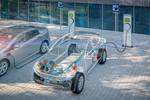EU LEVIS project to develop lightweight components for electric vehicles
Consortium to develop three large-scale, real-case demonstrators using multi-material solutions based on thermoplastic carbon fiber compounds integrated with metals.

Photo Credit: ITAINNOVA
It was recently announced that thirteen partners from various European countries have begun the first phase of the three-year EU-funded LEVIS project to develop lightweight components for electric vehicles (EVs) using multi-material production technologies and a circular economy approach. The consortium, made up of industrial partners and research centers from seven countries, and coordinated by the Technological Institute of Aragon ITAINNOVA (Zaragoza, Spain), will demonstrate the technical and economic feasibility of producing these cost-effective components in three large-scale, real-case demonstrators, including a suspension control arm, the system for clamping and packing the batteries and a cross beam.
“We will use multi-material solutions based on thermoplastic carbon fiber compounds integrated with metals, which will be produced through a set of profitable and scalable manufacturing technologies,” says Agustín Chiminelli, scientific coordinator of the project, Technological Institute of Aragon. “Thanks to their excellent mechanical properties, these composites, properly combined with metals, are ideal for light applications. In this regard, LEVIS aims to develop solutions for these multi-material components based on resins and environmentally friendly reinforcement systems, cost-effective manufacturing processes, optimized joints, advanced simulation methodologies and structural integrity monitoring technologies. The combination of these developments will allow us to obtain lightweight components.”
According to the consortium, such technologies could directly contribute to improving vehicle efficiency in terms of kilowatt-hours consumed per kilometer, as well as vehicle autonomy (kilometers per full battery cycle) and reducing environmental impact.
“The new lightweight components will be developed using a circular approach. This means that we will pay special attention to the use of recyclable materials and the design of the components so that, at the end of the useful life of the components, nothing will be wasted and each part can be recycled or reused for the same component or for other applications,” says Theodora Skordili, business development manager for Cenex Nederland.
Thus, priority will be given to recyclable resins and bio-based and recycled carbon fibers to develop the components. In addition, the useful life of these components will be optimized, and they will be designed to allow a simple and efficient disassembly and reuse.
The consortium, which will receive €4.9 million from the European Union (EU), has the ultimate goal of bringing these innovative components of electric vehicles to the market. To do this, LEVIS will follow a structured exploitation strategy, with protection of intellectual property, deployment of business models and an advanced commercialization plan.
Project partners include the Technological Institute of Aragon ITAINNOVA; Marelli Suspension Systems (MSS, Ovidio, Italy); Mersen France Angers SAS (Verrières-en-Anjou, France); Privé s.r.l. (Perugia, Italy); Yeşilova Holding A.Ş. (Turkey); Tofaş Türk Otomobil Fabrikasi A.Ş. (Istanbul, Turkey); Northwest Metallurgical Research Association (AIMEN, Spain); Association pour le Développement de l'Enseignement et des Recherches auprès des Universités, des Centers de Recherche et des Entreprises d'Aquitaine (CANOE, France), Leartiker S. Coop (Markina-Xemein, Spain); Rise Sicomp AB (Öjebyn, Sweden); Commissariat à l'Energie Atomique et aux Energies Alternatives (Atomic Energy and Alternative Energies Commission, CEA, Paris, France); Stichting Cenex Nederland (Amsterdam, Netherlands); and Steinbeis-Europa-Zentrum der Steinbeis Innovation GmbH (SEZ, Karlsruhe, Germany).
Related Content
-
Infinite Composites: Type V tanks for space, hydrogen, automotive and more
After a decade of proving its linerless, weight-saving composite tanks with NASA and more than 30 aerospace companies, this CryoSphere pioneer is scaling for growth in commercial space and sustainable transportation on Earth.
-
Sulapac introduces Sulapac Flow 1.7 to replace PLA, ABS and PP in FDM, FGF
Available as filament and granules for extrusion, new wood composite matches properties yet is compostable, eliminates microplastics and reduces carbon footprint.
-
Manufacturing the MFFD thermoplastic composite fuselage
Demonstrator’s upper, lower shells and assembly prove materials and new processes for lighter, cheaper and more sustainable high-rate future aircraft.
















